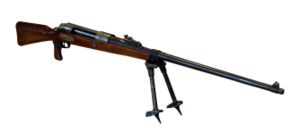- Mauser 1918 T-Gewehr
-
Mauser Mod. 1918 13.2 mm Tank Gewehr 
13.2 mm Rifle Anti-Tank at the Musée de l'Armée in ParisType Anti-tank rifle, Anti-materiel rifle Place of origin  German Empire
German EmpireService history In service 1918-1933 Used by  German Empire
German Empire
 Weimar Republic
Weimar RepublicWars World War I
German Revolution of 1918–1919
(Anti-Communist forces)Production history Manufacturer Mauser Produced Jan 1918 Number built 15,800[1] Variants M1918 shortened Specifications Weight 15.9 kg (35 lbs), 18.5 kg (41 lbs) loaded with the bipod Length 169.1 cm Crew two man crew Cartridge 13.2 mm TuF (German: Tank und Flieger) Caliber 13.2 mm (.525 inches) Action bolt-action Rate of fire single shot Effective range 500 m Feed system manual Sights 100 - 500 m (notched V) The Mauser 13 mm anti-tank rifle (German: Mauser 13,2 mm Tank Abwehr Gewehr Mod. 18, usually abbreviated T-Gewehr[2][3]) was the world's first anti-tank rifle,[4] i.e. the first rifle designed for the sole purpose of destroying armored targets and the only anti-tank rifle to see service in World War 1. Approximately 15,800 were produced [5]
Contents
History
It was a German weapon of World War I, appearing in February 1918. The Mauser Company began mass production at Oberndorf am Neckar in May 1918. The first of these off the production lines were issued to specially raised anti-tank detachments. The idea of using heavy calibre and high velocity rifles as anti-tank weapons originated in Germany. In June 1917, the German Army faced the menace of the Mark IV tank, and found that the armour-piercing 7.92 mm K bullet was no longer effective.
Operation
The rifle was a single shot bolt action rifle using the Mauser action, with rounds manually loaded into the chamber. The weapon had a pistol grip, bipod but no method of reducing the recoil such as a soft butpad or muzzle break. The iron sights were a front blade and tangent rear, graduated in 100 meter increments from 100 to 500 meters. The rifle was operated by a two-man crew of a gunner and ammunition bearer, who were both trained to fire the weapon. The high recoil of the rifle was very hard on the firer, sometimes breaking the collar bone or dislocating the shoulder.
Cartridge
The armour piercing hardened steel cored 13.2 x 92mm (.525-inch) semi-rimmed cartridge, often simply called "13 mm", was originally planned for a new, heavy Maxim MG.18 water-cooled machine gun, the Tank und Flieger (TuF) meaning for use against "tank and aircraft", which was under development and to be fielded in 1919. The round’s weighed 51.5g (795gn)with an initial velocity of 780m/sec (2,650ft/sec).
Survivors
The anti-tank rifle can be found in several museums: Patton Museum, Fort Knox, In Flanders Fields Museum, Ypres, The Imperial War Museum, King's Own Royal Border Regiment and 22nd Cheshire Regiment museums in the United Kingdom, the Army museum at the Invalides, Paris, and others.
Many modern rifles find their roots in the 13.2 mm Mauser, the most closely related being the Gepard rifle.[citation needed]
See also
- MG 18 TuF
References
- ^ http://books.google.com/books?id=Jixxq8Ln5lEC&lpg=PA108&dq=T-Gewehr%20%20number%20built&pg=PA108#v=onepage&q&f=false
- ^ Ball, Robert M. (2006). Mauser Military Rifles of the World (Mauser Military Rifles of the World). Gun Digest Books. pp. 183. ISBN 0-89689-296-4. http://books.google.pl/books?id=KlReVu0HziIC&printsec=frontcover&source=gbs_navlinks_s#v=onepage&q=&f=false.
- ^ Stephen Bull (2004). Encyclopedia of military technology and innovation. pp. 15. ISBN 9781573565578. http://books.google.pl/books?id=HN3AUx_3Mn4C&printsec=frontcover&client=firefox-a&source=gbs_navlinks_s#v=onepage&q=&f=false.
- ^ http://www.antitank.co.uk/ww1_anti-tank_rifles1.htm
- ^ http://books.google.com/books?id=Jixxq8Ln5lEC&lpg=PA108&dq=T-Gewehr%20%20number%20built&pg=PA108#v=onepage&q&f=false
External links
Categories:- Anti-tank rifles
- World War I German infantry weapons
- Firearms stubs
Wikimedia Foundation. 2010.
